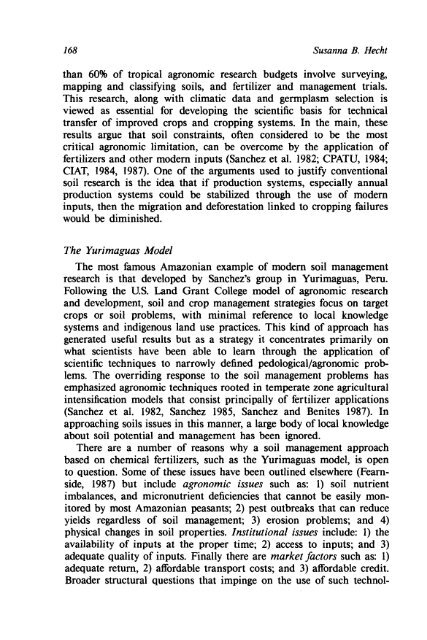Fragile Lands of Latin America Strategies for ... - PART - USAID
Fragile Lands of Latin America Strategies for ... - PART - USAID
Fragile Lands of Latin America Strategies for ... - PART - USAID
You also want an ePaper? Increase the reach of your titles
YUMPU automatically turns print PDFs into web optimized ePapers that Google loves.
168 Susanna B. Hecht<br />
than 60% <strong>of</strong> tropical agronomic research budgets involve surveying,<br />
mapping and classifiing soils, and fertilizer and management trials.<br />
This research, along with climatic data and germplasm selection is<br />
viewed as essential <strong>for</strong> developing the scientific basis <strong>for</strong> technical<br />
transfer <strong>of</strong> improved crops and cropping systems. In the main, these<br />
results argue that soil constraints, <strong>of</strong>ten considered to be the most<br />
critical agronomic limitation, can be overcome by the application <strong>of</strong><br />
fertilizers and other modem inputs (Sanchez et al. 1982; CPATU, 1984;<br />
CIAT, 1984, 1987). One <strong>of</strong> the arguments used to justifjl conventional<br />
soil research is the idea that if production systems, especially annual<br />
production systems could be stabilized through the use <strong>of</strong> modern<br />
inputs, then the migration and de<strong>for</strong>estation linked to cropping failures<br />
would be diminished.<br />
The Yurimaguas Model<br />
The most famous Amazonian example <strong>of</strong> modem soil management<br />
research is that developed by Sanchez's group in Yurimaguas, Peru.<br />
Following the U.S. Land Grant College model <strong>of</strong> agronomic research<br />
and development, soil and crop management strategies focus on target<br />
crops or soil problems, with minimal reference to local knowledge<br />
systems and indigenous land use practices. This kind <strong>of</strong> approach has<br />
generated useful results but as a strategy it concentrates primarily on<br />
what scientists have been able to learn through the application <strong>of</strong><br />
scientific techniques to narrowly defined pedological/agronomic prob-<br />
lems. The overriding response to the soil management problems has<br />
emphasized agronomic techniques rooted in temperate zone agricultural<br />
intensification models that consist principally <strong>of</strong> fertilizer applications<br />
(Sanchez et al. 1982, Sanchez 1985, Sanchez and Benites 1987). In<br />
approaching soils issues in this manner, a large body <strong>of</strong> local knowledge<br />
about soil potential and management has been ignored.<br />
There are a number <strong>of</strong> reasons why a soil management approach<br />
based on chemical fertilizers, such as the Yurimaguas model, is open<br />
to question. Some <strong>of</strong> these issues have been outlined elsewhere (Fearn-<br />
side, 1987) but include agronomic issues such as: 1) soil nutrient<br />
imbalances, and micronutrient deficiencies that cannot be easily mon-<br />
itored by most Amazonian peasants; 2) pest outbreaks that can reduce<br />
yields regardless <strong>of</strong> soil management; 3) erosion problems; and 4)<br />
physical changes in soil properties. Institutional issues include: 1) the<br />
availability <strong>of</strong> inputs at the proper time; 2) access to inputs; and 3)<br />
adequate quality <strong>of</strong> inputs. Finally there are market factors such as: 1)<br />
adequate return, 2) af<strong>for</strong>dable transport costs; and 3) af<strong>for</strong>dable credit.<br />
Broader structural questions that impinge on the use <strong>of</strong> such technol-

















